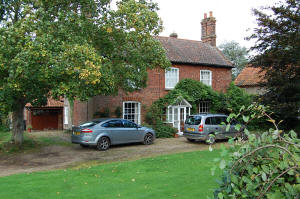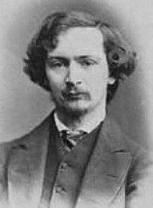Sidestrand
Sidestrand lies on the North Norfolk coast between
Overstrand and Mundesley.
When Clement Scott first visited the area in 1883 he was unable
to find accommodation in Cromer and subsequently walked out
to Sidestrand where he discovered lodgings at the Mill House
- then owned by Mr Jermy the miller. (The house lies on the
left hand side of the road and is now hidden by a fence and
hedge. According to the road sign, it is also lies in
Overstrand rather than Sidestrand.)

Old photograph of the The Mill House

The Mill House today
On the Norfolk coast, Scott discovered the unspoiled idyll he
was searching for and on his return to London he began to
write articles for The Daily Telegraph celebrating
the beauty of the area. This stimulated interest in North
Norfolk or 'Poppy Land' - as he dubbed it - and many other
Victorians took advantage of the new rail link to Cromer and
started to visit. Scott was also attracted to Sidestrand
because of the beauty of Louie Jermy - the daughter of the
mill owner. Their relationship was unrequited but obviously
played a vital part in his interest in the area. John
Madden's 1985 film 'Poppyland' dealt poignantly with this
relationship. Louie Jermy is buried in St. Michael's
churchyard at Sidestrand.
The term 'Poppyland' first appeared in Scott's poem The
Garden of Sleep which was set in the village churchyard
which sat perilously close to the cliff edge. The church
tower finally toppled into the sea in 1916. (The present church
was rebuilt in 1881 using flint from the original and a new
octagonal tower was constructed.)
|
|
The Garden of Sleep On the grass of the cliff, at the edge of the steep,
God planted a garden - a garden of sleep!
'Neath the blue of sky, in the green of the corn,
It is there that the regal red poppies are born!
Brief days of desire, and long dreams of delight,
They are mine when Poppy-Land cometh in sight.
In music of distance, with eyes that are wet,
It is there I remember, and there I forget!
O! heart of my heart! where the poppies are born,
I am waiting for thee, in the hush of the corn.
Sleep! Sleep!
From the Cliff to the Deep!
Sleep, my Poppy-Land,
Sleep!
In my garden of sleep, where red poppies are spread,
I wait for the living, alone with the dead!
For a tower in ruins stands guard o'er the deep,
At whose feet are green graves of dear women asleep!
Did they love as I love, when they lived by the sea?
Did they wait as I wait, for the days that may be?
Was it hope or fulfilling that entered each breast,
Ere death gave release, and the poppies gave rest?
O! life of my life! on the cliffs by the sea,
By the graves in the grass, I am waiting for thee!
Sleep! Sleep!
In the Dews of the Deep!
Sleep, my Poppy-Land,
Sleep!
|
Later in 1883 the poet A.C. Swinburne - together
with his companion Theodore Watts-Dunton - came to stay at
the Mill House and he produced a number of poems about the
location which later appeared in A Midsummer Holiday
(1884). Swinburne, who was suffering from alcoholism, used
to bathe in the sea off Sidestrand. Here is Swinburne's description of the
Mill
House garden in his typically mellifluous style:
|
|
The Mill Garden
Stately stand the sunflowers, glowing down the
garden-side,
Ranged in royal rank arow along the warm
grey wall,
Whence their deep disks burn at rich midnoon
afire with pride,
Even as though their beams indeed were
sunbeams, and the tall
Sceptral stems bore stars whose reign
endures, not flowers that fall.
Lowlier laughs and basks the kindlier flower
of homelier fame,
Held by love the sweeter that it blooms in
Shakespeare’s name,
Fragrant yet
as though his hand had touched and made it
thrill,
Like the whole world’s heart, with warm new
life and gladdening flame.
Fair befall the fair green close that lies
below the mill!
See complete poem
|
|

A.C.Swinburne |

Clement Scott |
Ironically, Scott soon came to realise
that his promotion of 'Poppy Land'
was endangering the
very quality which attracted
him to the region in the first place. In fact, he
feared that it would soon turn into
'Bungalow Land'.Craske's Tower - which
is mentioned in Scott's
poem
The Garden of Sleep - also inspired a poem by R. H. Mottram entitled
The Deserted Church
Tower on Sidestrand Cliff. The poem
is written from the church's point of
view. Here is part of the second verse:
|
My bell is gone, my porch is down;
Through my void windows now is blown
By every wind the day may send
The breath no preacher now will spend.
The young and old are here in rows,
Where, flowery tall, the sweet hay
grows;
They neither fidget now nor snore,
The young men eye young maids no more;
Read complete poem |
More Sidestrand photographs |
|

